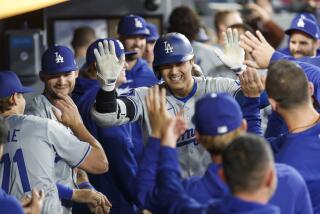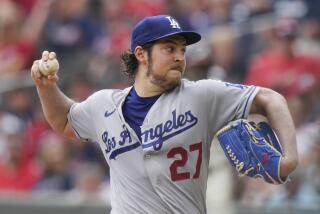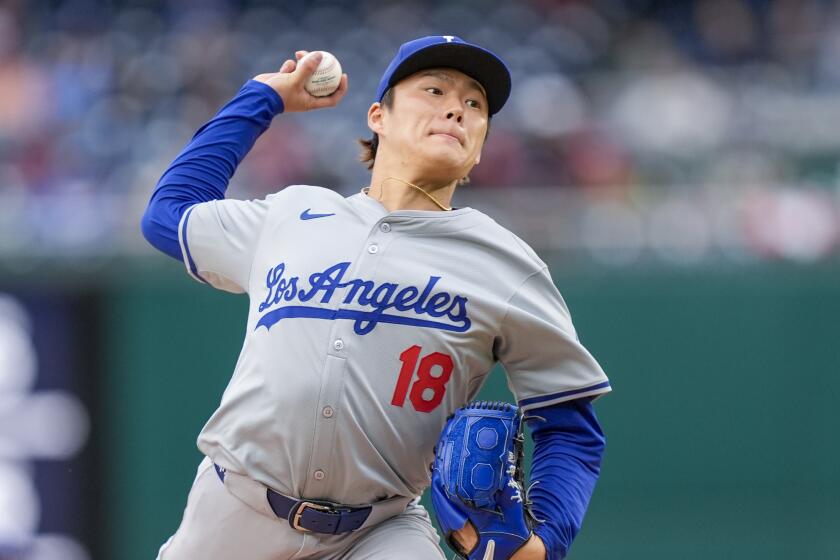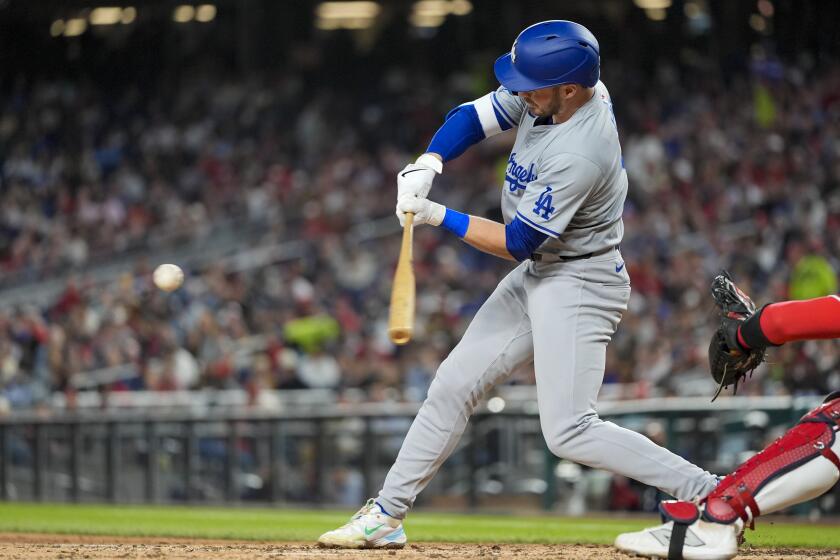Gripping disorder is the key for Kuo
The first pitch floated in and soared out, banging hard against the left-field wall, turning the quaint stadium deathly quiet.
What on God’s unforgiving earth does Hong-Chih Kuo do now? He spent the last month sidelined with an anxiety disorder. The first pitch of his comeback is hammered nearly 400 feet. What happens next?
Does he give in to the stage fright that buckled him in Pittsburgh? Is he swallowed by the yips that nipped him two seasons ago? What kind of sick joke is this, anyway?
The kid batter stood on second base with a double. Kuo wandered around the front of the mound as if lost. The smattering of fans at Rancho Cucamonga’s Epicenter stadium appeared to slip into a trance.
Then, furiously chewing gum, the tortured Dodger carefully climbed back on the rubber and threw another pitch. And another one. And another one.
Thirteen pitches after allowing the double, he had retired the next three batters, running off the field with a sweat-soaked grin, surviving the inning, surviving himself.
This, then, is how he will do it, climbing back from his nightmare one shaky fastball at a time.
“Step by step,” Kuo said later. “Step by step.”
There is no cheering in the press box, so on Thursday evening I sat in the stands rooting hard for the left-handed reliever in his first rehabilitation appearance for the Class-A Quakes, and aren’t we all?
A year ago Kuo was nearly unhittable. This year he has been nearly inconsolable.
A year ago, Kuo was the first player from Taiwan to appear in the All-Star game. This year, he sat in a clubhouse in early May and told his bosses that he simply couldn’t pitch anymore.
It wasn’t his arm that was terribly wild, it was his mind.
Although he walked six batters in 42/3 innings, he had not lost complete control of his throws like former Pittsburgh Pirates pitcher Steve Blass or former Dodgers second baseman Steve Sax, the two poster boys for this weird unnamed baseball affliction.
Kuo could throw it near the plate, he just couldn’t feel what he was throwing. Anxiety had consumed him such that it was if he was pitching with someone else’s arm. That somebody else had an 11.57 earned-run average and could no longer bear to face another hitter.
The Dodgers placed him on the disabled list for the second time in three years because of this condition, and now they must wait.
“This is not like a hamstring where you can see somebody get better or run faster,” said General Manager Ned Colletti. “This is a situation that only he can dictate, only he knows how he’s feeling.”
And how he is feeling?
“You probably know more about this than me,” Kuo said with a pained shrug.
The comeback is going to be a tough one.
Two seasons ago he missed nearly three months with a similar condition that the Dodgers initially called elbow problems.
They were understandably trying to protect his privacy in a sensitive matter for which the macho baseball culture has little patience.
This time there is no hiding the problem, and thus there will be no hiding his recovery, which will take place under the same sorts of pressure that caused this affliction in the first place.
After his shaky first outing Thursday while starting against the Visalia Rawhide, Kuo was pleasant, but unsettled, as if still trying to find answers where there are few.
When I asked if he had spoken to any player who had this affliction, he said, “Yeah, I talked to myself, I had it.”
When I asked what he thought about the length of his rehabilitation, he said, “I’m trying not to think about it.”
I cut the interview short. I was doing my job, but I wasn’t feeling great about doing it, putting him under a microscope that perhaps only makes this more difficult for him.
Sometime after Kuo had pitched his scoreless inning, allowing just the leadoff double while throwing nine strikes and five balls, I was sort of wondering why he couldn’t have started his rehab for, say, the Great Lakes Loons.
“At least this time I know what’s going on,” said Kuo. “I know what I’m feeling. I know how to get better.”
Two years ago, he was throwing baseballs from the bullpen onto the infield. Once, at the Dodgers’ training facility, he hit a trainer standing 30 yards away
This time he’s throwing it over the plate, just not very hard, and without much location, because part of him hasn’t been sure he’s throwing it at all.
“It’s the biggest dirty little secret in baseball,” said Richard Crowley, a Santa Barbara psychologist who has worked with Blass and Sax. “All of a sudden, out of the blue, you can’t feel the ball, and you are afraid to let it rip.”
Part of Kuo’s problems could come from his four elbow surgeries.
Knowing that he’s always just one pitch from ending his career at age 29 surely works on his mind.
More pressure is added when one considers Kuo is trying to live up to his role as Taiwan’s leading major league representative.
In a bit of sad irony, Tuesday at Dodger Stadium is Hong-Chih Kuo Bobblehead Night, with ceremonies celebrating all things Taiwan.
No, Kuo is not expected to be back in the Dodgers’ dugout by then.
“You’re throwing the ball and you’re thinking, ‘I’m in trouble,’ and the pressure builds it and it all spins out of control,” said Crowley.
Incidentally, I’ve seen the Kuo bobblehead doll. It doesn’t look anything like him.
twitter.com/billplaschke
More to Read
Are you a true-blue fan?
Get our Dodgers Dugout newsletter for insights, news and much more.
You may occasionally receive promotional content from the Los Angeles Times.







